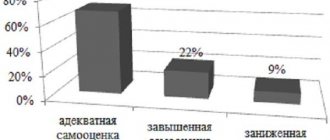Rosenberg Self-Affirmation Scale
Personal self-esteem can change under the influence of various factors. You can check your level of self-esteem using the Rosenberg technique. Indicators on the questionnaire determine whether an individual has depression, excessive anxiety, signs of a leader, and activity in communication.
The subject must indicate his attitude to the given statements on a scale:
- I completely agree;
- agree;
- disagree;
- I absolutely disagree.
The test consists of the following statements:
- I consider myself a worthy person, no worse than others.
- They constantly feel like a failure.
- I have good qualities.
- Able to do something as well as others.
- I have nothing to be proud of.
- I treat myself well.
- Satisfied with his own personality.
- I wish I had more respect for myself.
- Sometimes I feel useless.
- I often think that I am bad at everything.
Points are awarded for each answer. The Rosenberg self-esteem test will show your attitude towards yourself in the form of the sum of points received by the subject.
Dembo-Rubinstein test
A vertical line is drawn on the sheet, indicating a feeling, for example, happiness. The top of the line corresponds to the happiest person, and the bottom to the unhappy one.
Are you ready to stop thinking about your problem and finally move on to real actions that will help you get rid of your problems once and for all? Then perhaps you will be interested in this article .
The subject must draw a line on the line that will indicate his current level. A satisfactory level of development is marked with a circle, and the place corresponding to an objective assessment of capabilities is marked with a cross.
The technique contains a scale of health, mental development, character and happiness.
To make the test more convenient, the height of the line should be 100 mm, and a point is awarded for each mm. First you need to complete the test, and only then read the interpretation of the results, otherwise this will affect the honesty of the answers.
As a result, you can find out the main parameters of self-esteem:
- Height. If the result is 75-100 points, then self-esteem is inflated, and the person is closed to gaining new experience and does not accept his mistakes and the comments of other people. Scores below 50 are obtained by individuals with low self-esteem.
- Level of aspiration. It is marked with a cross on the scale. Real results are 60-90 points. If a higher score is received, then the person assesses his capabilities unrealistically and uncritically. Indicators below 60 points indicate low aspirations and unfavorable personality development.
Normal self-esteem on the scale is above the middle. The ideal indicator is a circle slightly below the top plus, and (x) between them.
Processing the results
Processing is carried out on six scales (the first, training - “health” - is not taken into account). Each answer is expressed in points. As noted earlier, the dimensions of each scale are 100 mm, according to which the students’ answers receive a quantitative description (for example, 54 mm = 54 points).
1. For each of the six scales, determine:
a) level of claims - the distance in mm from the bottom point of the scale (“O”) to the “x” sign;
b) the height of self-esteem - from “0” to the “x” sign;
c) the value of the discrepancy between the level of aspirations and self-esteem - the distance from the “x” sign to the “-” sign; if the level of aspirations is lower than self-esteem, it is expressed as a negative number.
2. Calculate the average value of each indicator on all six scales.
Sonerson test
This method of identifying low self-esteem was proposed by psychologist Marilyn Sonerson.
More than 9,000 people have gotten rid of their psychological problems using this technique.
You can take the test online; the higher the score, the lower your self-esteem:
- 0-7 points indicate an ideal state, independence and autonomy;
- 8-15 points indicate average self-esteem. In this case, a person sometimes worries about his appearance and the opinions of others;
- 16-25 – low self-esteem;
- 26-50 points signal excessively low self-esteem, which causes mental and physical discomfort.
The Sonerson test will help you identify problems with self-confidence and find out at what stage you need the help of a psychologist.
Ponomarenko test
Diagnosis of personal problems is carried out using a special form. It shows character traits, a total of 15 positive and the same number of opposite ones.
If you don’t want to give up and are ready to really, and not in words, fight for your full and happy life, you may be interested in this article .
In the middle of the form there are columns numbered from 1 to 7; the choice must be made depending on how pronounced the pair of qualities is:
- The column with number 1 says that the person does not have a drop of anger.
- The seventh column shows a person who is 100% evil.
- The fourth is chosen by people with an average position of kindness and anger.
- The third says that the subject is more kind than evil, and the second says the opposite.
The closer the column is to the right or left side of the properties, the more pronounced they are.
Testing consists of several stages:
- First, select the column number, indicating it with a cross.
- Return to the first pair of characteristics and indicate the desired properties with a circle.
- Finally, the results are processed. In each pair, the position of the real state and the desired state is considered.
At the final stage, the difference in the positions of all 15 digits is summed up and the results are compared with the key.
If a problem is discovered, the person considers himself worthless, insignificant, and often speaks self-deprecatingly. It is also difficult for him to accept compliments, refuse another person, and defend his opinion. This condition is inherent in asthenics.
The reasons for low self-esteem are hidden in childhood, when the child is scolded for the slightest offense, reacts to him aggressively and irritably, and is not supported. A problem can also arise in an adult due to unpleasant events in life, for example, dismissal from work or financial insolvency.
The type of temperament also influences your attitude towards yourself. Sanguine and phlegmatic people usually have a stable psychological state, while for choleric people it constantly fluctuates. Melancholic people always have low self-esteem. Therefore, they need to develop confidence.
Difficult period in life
Adolescence is a difficult period in life when a child ceases to be a child, but is not yet an adult. At the same time, society sets its own conditions for him: the teenager does not yet have complete freedom, his will is limited, but he feels like a mature person, capable of making serious decisions, and control begins to burden him. The worldview is changing, he is looking for new guidelines. Maxim Gorky once succinctly expressed himself in his work “Theatrical”: “When I was fifteen years old, I felt very weak, unstable on the ground, everything beneath me seemed to be swaying, falling through...”
These words can describe the feeling of most teenagers during the period of growing up. Their self-esteem is also greatly tested.
It is already more difficult for parents to find a common language with them, because they are reluctant to share their experiences. They are characterized by anxiety, suspiciousness, and exaggeration. It is no longer easy to understand where their behavior is feigned and where real problems begin.
In order to find out the level of self-esteem of adolescents, various methods are used. Let's take a closer look at them.
Gorbatov test
Low self-esteem of a woman or man requires treatment. They try to increase confidence through training and sessions with a psychologist.
Violations can be recognized using the Gorbatov test. It is based on ideas about personality traits. These qualities are taken into account during education.
A task consisting of several stages will help you understand your own ideas about the ideal:
- The sheet is divided into 4 parts and each is signed with Roman numerals. The subject receives 4 sets of positive character traits and in each set he must highlight the most valuable and significant ones. They are written out in a column along with the number. In this way, all qualities are processed.
- At the second stage, they carefully consider the written qualities and find those that they possess in reality. They are circled.
After this, the result is calculated: the real qualities are divided by the number of ideal ones and multiplied by 100%. If the result is 0-10 points for men and 0-15 for women, then self-esteem is inadequately low. The higher the result, the less self-doubt.
More than 9,000 people have gotten rid of their psychological problems using this technique.
Kazantseva's test
The provisions are read to the subject, and he must write down three possible answers: “yes”, “no”, “I don’t know”. Choose the option that best matches the behavior. Answers are given quickly, without hesitation.
Examples:
- I always expect success.
- No self-confidence.
- In terms of abilities and resourcefulness, I do not lag behind those around me.
- Periodically they feel useless.
- It seems like I can't achieve anything.
- I often do things that I regret.
- I don't worry about possible failures.
- Various obstacles always prevent me from successfully completing assignments.
- I think that someone always needs me.
- I think I do worse than others.
- I'm usually lucky.
You can find out your own level of self-esteem after calculating the results. First, they count how many affirmative answers there are with odd numbers, and then with even numbers. The second number is subtracted from the first number. The result can range from -10 to +10. If the score is from -10 to -4, then self-esteem is low, and from -3 to +3 - average. Individuals with a high level of self-confidence receive more values.
Why should everyone get tested?
The technique was developed by the famous Soviet psychologist Sergei Andreevich Budassi in the 1970s. Even today, the Budassi test is successfully used by psychologists all over the world.
Analysis helps to determine the “I-concept”, the average value of the “Real-I” and the “Ideal-I”. It is the “I-concept” that influences the choice of a person’s type of behavior, which, in turn, determines the direction of activity, actions and communications.
Why is it important to understand your self-concept? Not everything we think about ourselves is 100% real. Some aspects of our personality are not perceived by consciousness and are realized by us unconsciously. The Budassi test allows us to determine the level of our self-esteem, and, based on this knowledge, adjust our actions and decisions.
Adapted version of Eysenck's technique
To identify deviations in the perception of one’s own personality, a technique is used that contains a description of various mental states. If a person feels this often, he gives 2 points, occasionally - 1, never - 0.
First group:
- I feel insecure.
- I blush over trifles.
- I sleep restlessly.
- I get discouraged easily.
- I'm worried about possible troubles.
- I'm afraid of difficulties.
- I constantly dig into the shortcomings.
- I'm easily convinced.
- Suspicious.
- I can't bear the wait.
Second group:
- Often even a simple situation seems hopeless.
- I get discouraged because of troubles.
- I blame myself for big failures.
- I don't learn from misfortunes.
- I refuse to fight, considering it useless.
- I feel helpless.
- I often despair.
- Confused by difficulties.
- In difficult moments, I behave like a child in order to gain pity.
- I believe that my shortcomings cannot be overcome.
Third group:
- The last word is always mine.
- I often interrupt my interlocutors.
- I get angry easily.
- I make comments to others.
- I'm trying to be an authority figure.
- I'm not content with little.
- I can't control my anger well.
- I prefer control to submission.
- I gesture sharply and rudely.
- Revengeful.
Fourth group:
- It's hard to change habits.
- It's difficult to switch attention.
- I am wary of innovations.
- It's hard to convince.
- I suffer from obsessive thoughts.
- It's difficult to get close to people.
- I get upset, even if plans are slightly disrupted.
- Often stubborn.
- I rarely take risks.
- I often deviate from my daily routine.
The results can be determined after calculating the sum of points.
Similar techniques are often used to study student self-esteem. This allows them to form an image of themselves, correct uncertainty, and learn to correctly assess their own personality.
Distortion of self-esteem arises as a result of discrepancies between aspirations and actual achievements. The greater the claims, the more success a person must achieve in order to satisfy them.
Take the self-esteem test
Test for the level of self-esteem Photo: Depositphotos
The test for the level of self-esteem includes 15 statements with four answer options:
- Very often – 4 points;
- Often – 3 points;
- Sometimes – 2 points;
- Rarely – 1 point;
- Never – 0 points.
Each option is worth a certain number of points. Choose the answers that most accurately indicate how often you find yourself in this state.
Time limit: 0
Navigation (job numbers only)
0 out of 15 tasks completed
Questions:
- 1
- 2
- 3
- 4
- 5
- 6
- 7
- 8
- 9
- 10
- 11
- 12
- 13
- 14
- 15
Information
Self-esteem test
You have already taken the test before. You can't start it again.
The test is loading...
You must log in or register in order to begin the test.
You must complete the following tests to start this one:
results
Your time:
Time's up
You scored 0 out of 0 points (0)
Categories
- No category 0%
- You can see the test results below.
- 1
- 2
- 3
- 4
- 5
- 6
- 7
- 8
- 9
- 10
- 11
- 12
- 13
- 14
- 15
- With answer
- With a viewing mark
- Task 1 of 15
1.
1. I often worry unnecessarily.
- Task 2 of 15
2.
2. I want my friends to cheer me up.
- Task 3 of 15
3.
3. I'm afraid of looking stupid.
- Task 4 of 15
4.
4. I'm worried about my future.
- Task 5 of 15
5.
5. Others' appearance is much better than mine.
- Task 6 of 15
6.
6. What a pity that many people don’t understand me.
- Task 7 of 15
7.
7. I feel like I don’t know how to talk to people properly.
- Task 8 of 15
8.
8. People expect a lot from me.
- Task 9 of 15
9.
9. I feel constrained.
- Task 10 of 15
10.
10. It seems to me that some trouble is about to happen to me.
- Task 11 of 15
11.
11. I worry about how people treat me.
- Task 12 of 15
12.
12. I feel like people are talking about me behind my back.
- Task 13 of 15
13.
13. I don't feel safe.
- Task 14 of 15
14.
14. I have no one to share my thoughts with.
- Task 15 of 15
15.
15. People are not particularly interested in my achievements.
Leary test
The method allows you to explore a person’s idea of his own personality. Each of them needs to be assessed as follows: if the definition corresponds to ideas about oneself, a plus is placed opposite it, and if not, a minus. You must answer questions sincerely.
Upon completion, points are calculated using the key to the questionnaire (the difference between ideas about a person and the desired image is important). The maximum result is 16 points.
Types of personal characteristics identified during testing:
- Authoritarian. If a person scores from 13 to 16 points, then he is distinguished by authority, increased despoticism, and is a leader in all types of activities. They love to teach others and do not take advice from others. From 9 to 12 points are scored by energetic, competent people who demand respect for themselves. 0-8 points indicate a self-confident person, but he will not necessarily be a leader.
- Selfish. 13-16 shows the desire to be above others, prudence and independence. Such a person likes to shift responsibility to others and is boastful and arrogant. From 0 to 12 for people with egoistic traits and a tendency to compete.
- Aggressive. 13-16 points indicate a person’s harshness and hostility towards others. This often leads to antisocial behavior. 9-12 means that a person is frank and strictly evaluates others, often mocks and criticizes. 0-8 points indicate stubbornness, perseverance, perseverance and energy.
- Suspicious. 13-16 points are scored by individuals with a schizoid character type, who have an aloof attitude towards the world, doubt everything and are always dissatisfied. 9-12 points indicate difficulties in contacts with people due to uncertainty, fear of the bad attitude of others, secrecy and isolation. 0-8 speaks of being critical of yourself and the entire world around you.
- Subordinate. 13-16 points are scored by people who are submissive and prone to low self-esteem. They always give in to others, and put themselves in last place, feel guilty for any reason, are passive and try to find support for themselves. 9-12 – the subject is shy and timid, has a predisposition to subordination, always follows the orders of others and does not have an opinion.
- Dependent. 13-16 indicates self-doubt, anxiety, dependence on other people's opinions. 9-12 points are scored by obedient, fearful and helpless individuals who are unable to resist. 0-8 – a person is distinguished by his gentle character and gullibility, often admires others.
- Friendly. 9-16 – the individual strives to gain social approval and be good to everyone. 0-8 – often compromises in conflict situations, follows all rules and conventions, wants to be the center of attention. Warm and friendly in his relationships with others.
- Altruistic. Hyper-responsible people score 9-16 points. They always sacrifice their interests, impose help and are overly active. But this is only a mask that hides the opposite type. 0-8 points indicate selflessness and emotional attitude towards others. This is a kind person who always encourages and calms in a difficult situation.
The first four results are obtained by people who are accustomed to defending their opinions and occupying leading positions. The other four options paint the opposite picture.
Tests to determine self-esteem are also administered to adolescents. This period is considered the optimal phase for working with self-esteem. This is associated with the formation of a full-fledged self-awareness. Parents should provide the opportunity to talk openly about exciting topics and conduct dialogue on equal terms, supporting the teenager in solving problems.
At the age of 9-12 years, aggression and parental rejection, combined with low self-esteem, can lead to serious disturbances in personality formation.
At a young age, self-esteem is based on the opinions of others. It is installed without critical analysis. This influence is very significant.
How to deal with a teenager?
Try to understand and accept
Now imagine that you are the parents of a teenager. Due to changes in his behavior, it can be difficult for you. But you still love your child, and you are not indifferent to how he treats himself. You are worried about his emotional state.
Sometimes you are offended that he does not share the details of his life with you, has become secretive, is rude, and brushes it off. He may even have become prone to deviant behavior. But you want to improve the relationship, and you really want your child to trust you.
The first reaction to his behavior is irritation. Maybe you don’t even particularly hold back your emotions or choose your words when expressing your complaints. But remember: the child’s behavior is aimed not only at self-expression, but also at getting you to pay attention to him.
Believe me, he himself really wants everything to be fine with you.
The peculiarity of his worldview is that it seems to him that no one understands him. Therefore, deep down in his soul, he really wants you to understand his throwing and accept him for who he is now. He doesn't talk to you because he's afraid of your reaction. Try to restrain yourself, try to calm down.










